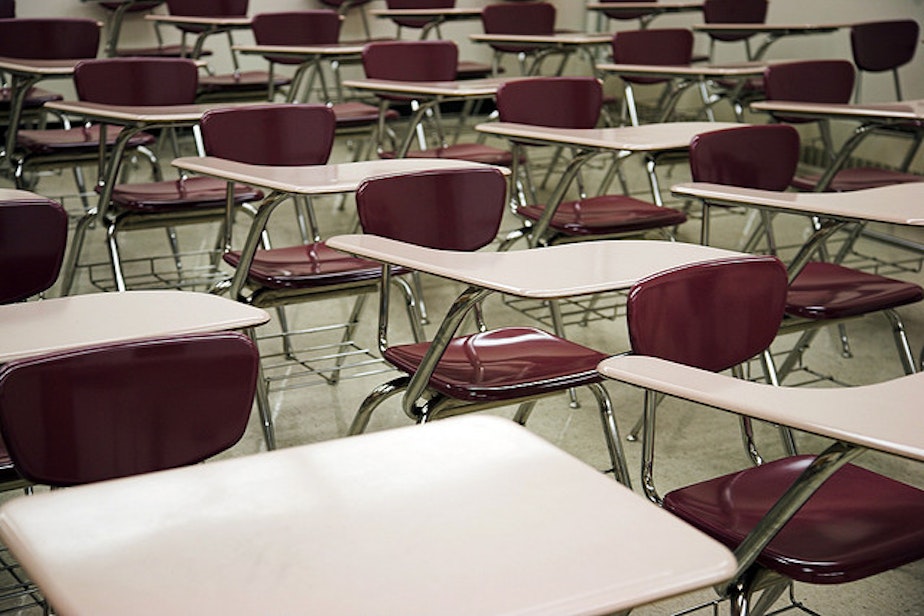Paying To Cut Seattle Class Sizes Doesn't Necessarily Make Them Smaller

The Washington state Legislature has directed funding to reduce class sizes in elementary schools.
But as KUOW’s Ann Dornfeld reports, that doesn’t mean classes are getting much smaller.
TRANSCRIPT
At Catharine Blaine K-8 in Seattle, Lisa Duke’s fifth-graders start each school day the same way: singing the class roster.
There are 30 names in the song.
Sponsored
That’s how many kids are squeezed into this portable.
Duke: “It’s difficult for me to even navigate around the classroom to get to the kids who have a hand raised in the air. And the kids trying to get up to turn in work or go sharpen a pencil are running into other kids in the classroom and it just creates a really stressful environment overall.”
Duke has been teaching for two decades.
She says the space constraints in a large class are just part of the problem.
Duke: “A teacher’s biggest challenge in any size classroom is trying to serve the need of a diverse population. Always, we have kids who range from very, very below standard to kids who need a challenge way above standard. So the more kids we get the harder that challenge is and it’s harder with a system that’s not supporting us and trying to keep those numbers low.”
Sponsored
The state Legislature did increase funding earmarked for smaller class size this year.
But the funding only goes to grades K through three.
Studies show that young children benefit the most from small classes.
But making classes smaller requires additional classrooms.
Johnson: “The problem with that, of course, is that you have to offset somewhere. What ends up happening then is the upper grades can often have more kids.”
Sponsored
Heather Johnson is the principal at Blaine.
She says even if the school had enough money for more teachers at all grades, it wouldn’t make classes smaller.
Johnson: “I literally have no more classroom space available. I have a class being taught on the stage. I have a class being taught in the cafeteria when kids are not eating lunch.”
The state Office of Superintendent of Public Instruction estimates that in order to meet the Legislature’s student-teacher ratio goals, the state needs nearly 6,000 new elementary classrooms in the next two years.
The price tag? $2 billion.
Sponsored
That’s not part of the Legislature’s class size budget.
In the short term, the state’s funding model creates a workaround for districts.
At Dick Scobee Elementary School in Auburn, there are 25 students in this second-grade class.
The state funds 22 students in a high-poverty second grade like this.
The numbers don’t add up – but the school is still in compliance.
Sponsored
That’s because the Legislature didn’t fund class size – it funded student-teacher ratios.
The state calculates the ratio by dividing the number of students in grades K through 3 in each district by the number of certificated teachers who work with those students in any capacity.
Librarians, gym teachers, reading specialists – everyone.
The result is that most classes are larger than the student-teacher ratio.
We don’t know exactly how large because the state doesn’t collect data on class size – just on the district-wide student-teacher ratio.
Santos: “The ratio approach is to say, OK, formulaically we can say that this might approach a reasonable standard of students to teacher at this particular grade.”
Rep. Sharon Tomiko Santos is chair of the House Education Committee.
She says funding using a ratio like that is meant to give communities control over the class sizes that works best for them.
Santos: “That’s why we have local control is we can’t say what is going to work in Seattle is what is going to work in Steilacoom or Selah.”
So are class sizes too big in any of those Washington cities?
Santos says that’s not for her to say.
Instead, she points to how U.S. high-schoolers rank on the international assessment known as the PISA compared to students in the highest-scoring countries.
“They have class sizes that are comparable to our national averages – and larger – and yet they outperform. So I am not going to personally judge any classroom to be too crowded.”
Santos says that’s up to communities to decide.
“As we drive the dollars out at the state level, we trust that the locally-elected school board members will make the right decisions. If they don’t, then I think the parents of the students who are enrolled in those schools really should take it up with the board.”
Washington voters have taken it up with their representatives – in the Legislature.
Last fall voters approved Initiative 1351, which would dramatically lower class sizes for every grade.
The Legislature declined to fund the law and delayed its implementation for four years.
I’m Ann Dornfeld, KUOW News.

